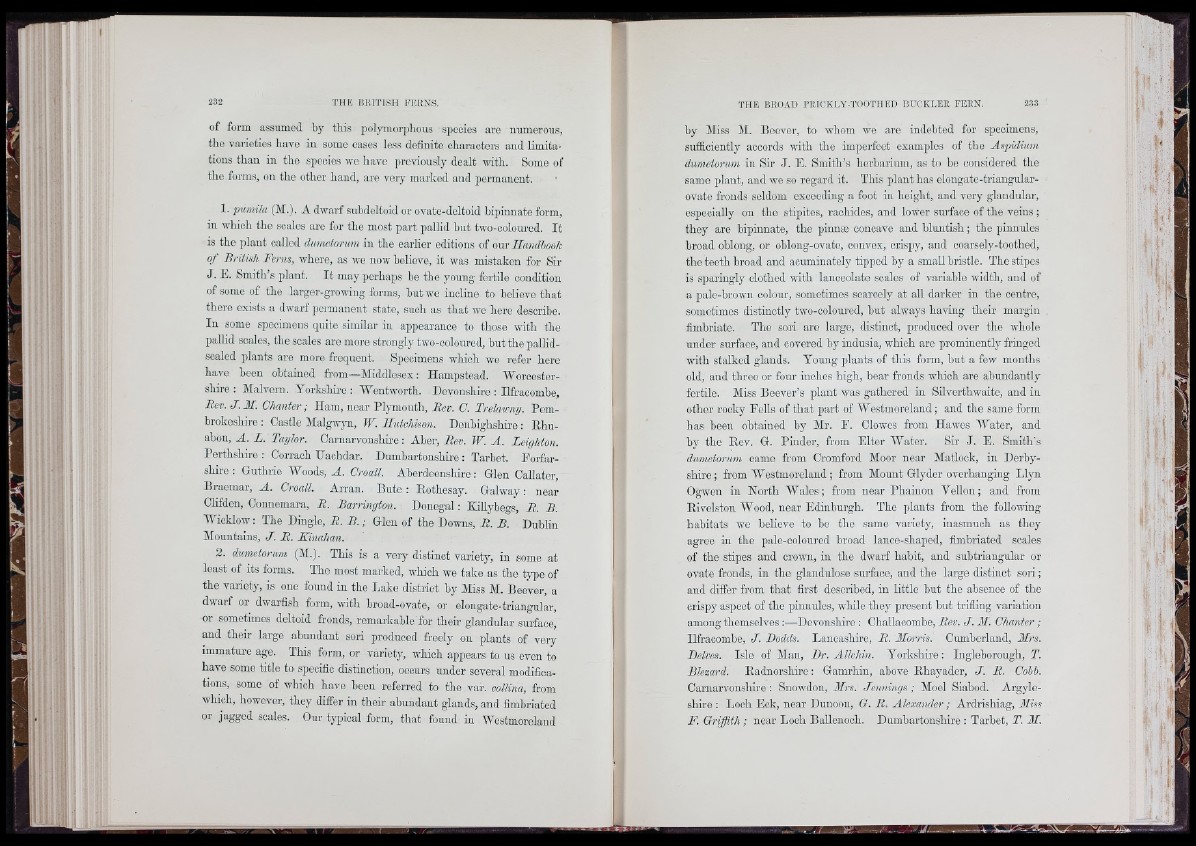
of form assumed by this polymorphous spooies are numerous,
tho varictios havo in some cases loss definite characters and limitations
than in the spccios wc havo proriously dealt with. Some of
tho forms, on tho other hand, aro very marked and permanent.
1. pumila (j\I.). A dwarf suhdeltoid or ovate-deltoid hipmnate form,
in which the scales aro for the most part pallid hut two-coloured. I t
is tho plant called dumetorum in the earlier editions of our Handhook
o f British Ferns, whoro, as we now believe, it was mistaken for Sir
J. E. Smith’s plant. I t may perhaps be the young fertile condition
of some of tho largor-growing forms, but we incline to believe that
there exists a dwarf permanent state, such as that we horo describe.
In some spooimons quite similar iu appearance to those with the
pallid scales, the scales arc more strongly two-colourod, but tho pallid-
scaled plants aro moro frequent. Specimens which we refer here
have been obtained from—Middlesex: Hampstead. Worcestershire
: Malvern. Yorkshire : Wentworth. Devonshiro : Ilfraoomhe,
Bev. J . M. Chanter; Ham, noar Plymouth, Bev. O. Trelmvny. Pembrokeshire
: Castle Malgwyn, W. Hutchison. Denbighshire; Ehu-
ahon, A . L . Taylor. Carnarvonshire; Aher, Bev. JF. A . Leighton.
Perthshire ; Corrach Uachdar. Dumbartonshire : Tarhet. Forfarshire
: Guthrie Woods, A. Croall. Aberdeenshire; Glen Callater,
Braemar, A . Croall. Arran. Bute : Rothesay. Galway; near
Clifden, Connemara, B . Barrington. Donegal: KiUybegs, B. B.
JYicklow: The Dingle, B . B . ; Glon of the Downs, R . B. Dublin
Mountains, J . B. Kinahan.
2. dumetorum (M.). This is a very distinct variety, in some at
least of its forms. The most marked, which we take as the type of
the variety, is one found in the Lake district by Miss M. Beever, a
dwarf or dwarfish form, with broad-ovate, or elongate-triangular,
or sometimes deltoid fronds, remarkable for their glandular surface,
and their large abundant sori produced freely on plants of very
immature age. This form, or variety, which appears to us even to
have some title to specific distinction, occurs under several modifications,
some of which have been referred to the var. collina, from
which, however, they differ in their abundant glands, and fimbriated
or jagged scales. Our typical form, that found iu Westmoreland
by Miss M. Boever, to whom we are indebted for specimens,
sufficiently accords with tho imperfect examples of the Aspidium
dumetorum in Sir J. E. Smith’s horharium, as to be considered the
same plant, and wo so regard it. This plant has elongato-triangular-
ovato fronds seldom oxoeoding a foot in height, and very glandular,
especially on tho stipites, raohides, and lower surface of the veins ;
they aro bipinnate, the pinnæ concave and bluntish ; tho pinnules
broad oblong, or ohlong-ovatc, convex, crispy, and coarsely-toothed,
the teoth broad and acuminatcfy tipped hy a small bristle. The stipes
is sparingly clothed with lanceolate scales of variable width, and of
a pale-hrown colour, somotimos scarcely at all darker in the centre,
sometimes distinotiy two-oolourcd, but always having their margin
fimbriate. The sori aro largo, distinct, produced over the whole
under surface, and covered by indusia, which aro prominently fringed
with stalked glands. Young plants of this form, but a few mouths
old, and threo or four inches high, boar fronds which are abundantly
fertile. Miss Beevor’s plant was gathered in Silverthwaite, and in
other rocky Fells of that part of Westmoreland ; and the same form
has been obtained by Mr. F. Clowes from Ilawes Water, and
by the Rev. G. Pinder, from Eltor Water. Sir J. E. Smith's
dumetorum came from Cromford Moor near Matlock, in Derbyshire
; from Westmoreland ; from Mount Glyder overhanging Llyn
Ogwen in North Wales; from noar Phainon Vellón; and from
Rivelston JYood, near Edinburgh. The plants from the following
habitats we believe to he the same variety, inasmuch as they
agree in the pale-coloured broad lanoe-shaped, fimbriated scales
of the stipes and crown, in tho dwarf habit, and snbtriangular or
ovate fronds, in the glandulose surface, and the large distinct sori ;
and differ from that first described, in little hut the absence of the
crispy aspect of the pinnules, while they present hut trifling variation
among themselves :—Devonshire : Challacombe, Bev. J . M. Chanter ;
Ilfracombe, J . Bodds. Lancashire, B. Morris. Cumberland, Mrs.
Delves. Isle of Man, Dr. Allchin. Yorkshire : Ingleborough, T.
Blezard. Radnorshire : Gamrhin, above Rhayader, J . R . Cobb.
Carnarvonshire : Snowdon, Mrs. Jennings ; Moel Siabod. Argyleshire
: Looh Eck, near Dunoon, G. R. Alexander ; Ardrishiag, hl'tss
F. Griffith ; near Loch Ballenooh. Dumbartonshire : Tarhct, T. M.